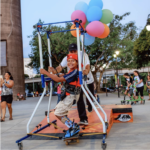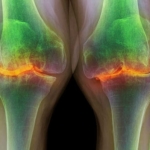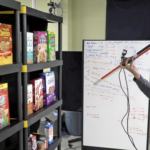Fall risk reduced in older adults with exercise

10 things you can do to prevent devastating falls. A new study shows we know how to stop the leading cause of injury among older people, writes Dr. Eric B. Larson. All we have to do is use that knowledge.
By Lisa Rapaport, Medscape December 20, 2019
Reuters Health – Older adults who exercise may reduce their risk of falls by more than a third compared to sedentary peers, a research review suggests.
Workouts that focus on improving balance, coordination, mobility, and flexibility all may help reduce the risk of falls compared with no exercise at all, the study found. And getting a variety of different types of exercise may have the greatest effect, regardless of whether individuals start out with a low or high risk for falls.
“All older adults should be regularly undertaking exercises that safely challenge their balance to prevent falls,” said Cathie Sherrington of the University of Sydney, in Australia, the study’s lead author.
“Frailer people should see a health professional for such exercise to be prescribed but fitter people can attend a local gym or community exercise class,” Sherrington said by email. “The trick is to find an exercise regimen that you enjoy and will stick too as it fits with your other priorities and commitments.”
The results of the current study, published in the British Journal of Sports Medicine, update findings Sherrington and colleagues reported in January 2019 in the Cochrane Library, which analyzed results from randomized controlled trials through May 2018.
The current study includes findings from 25 countries, including some results that were not available when the original came out, and provides more certainty about the effect of exercise on older adults, Sherrington said.
For the current analysis, researchers examined data from 59 trials with a total of almost 13,000 participants. They found high-certainty evidence that exercise reduces the rate of falls by 23% among adults aged 60 and up.
Exercise was associated with a similar reduction in the risk of falling when the researchers only looked at adults 75 and older, as well as for people with a high risk for falls.
Balance and functional exercises were associated with a 24% lower risk of falls, the study found. And doing multiple types of exercises – typically a mix of balance and functional workouts as well as resistance training to improve muscle strength – was associated with a 34% lower risk of falls compared to no exercise.
Tai chi, a Chinese meditation practice that combines deep breathing and slow, fluid movements, was associated with a 19% lower risk of falling.
Workouts supervised by physical therapists or other health professionals appeared more effective at reducing the risk of falls than unsupervised exercise.
Researchers didn’t have enough data to determine whether workouts that only involve resistance exercises, walking or dancing might reduce falls.
Most of the smaller studies in the analysis didn’t report the risk of fracture, hospitalization, medical attention, or other adverse events associated with falls, the authors note.
The analysis also wasn’t designed to determine what exact exercises to do or how intensely or frequently people need to exercise for maximum fall-prevention benefits.
While exercise can help prevent falls, many other precautions also matter, said Dr. Eric Larson of the Kaiser Permanente Washington Health Research Institute in Seattle.
“Exercise, if you don’t already do so, is really valuable,” Dr. Lawson, who wasn’t involved in the study, said by email. “Aim for at least 30 minutes a day on most days – more might be better if it’s not too exhausting.”
Fall-proofing at home is also key, he said.
“Check for loose rugs, cords, and other items that you could trip on,” Dr. Lawson advised. “Get good lighting and, for nighttime, get motion lights near your bed, especially if you often go to the bathroom at night.”
Footwear matters, too.
“Avoid walking around barefooted or in stocking feet – a good tennis shoe is often safest of all shoes,” Dr. Larson added. “Don’t be too proud to use a cane or walker if your balance is poor and especially if you are prone to falling, and use the cane or walker to stay as physically active as possible.”
Source Medscape, Reuters Health Information
| References |
Exercise for preventing falls in older people living in the community: an abridged Cochrane systematic Review, Sherrington C, Fairhall N, Wallbank G, Tiedemann A, Michaleff ZA, Howard K, Clemson L, Hopewell S, Lamb S. Br J Sports Med. 2019 Dec 2. pii: bjsports-2019-101512. doi: 10.1136/bjsports-2019-101512. [Epub ahead of print] Review.
Exercise for preventing falls in older people living in the community, Sherrington C, Fairhall NJ, Wallbank GK, Tiedemann A, Michaleff ZA, Howard K, Clemson L, Hopewell S, Lamb SE. Cochrane Database Syst Rev. 2019 Jan 31;1:CD012424. doi: 10.1002/14651858.CD012424.pub2.
| Further reading |
What are the effects of exercise interventions for preventing falls in older people living in the community? – A Cochrane Review summary with commentary, Fusco A. J Musculoskelet Neuronal Interact. 2019 Dec 1;19(4):385-388. No abstract available. PDF
Long-term follow-up of exercise interventions aimed at preventing falls in older people living in the community: a systematic review and meta-analysis, Finnegan S, Seers K, Bruce J. Physiotherapy. 2019 Jun;105(2):187-199. doi: 10.1016/j.physio.2018.09.002. Epub 2018 Sep 20.
Are multifactorial and multiple component interventions effective in preventing falls in older people living in the community? A Cochrane Review summary with commentary, Fusco A. J Musculoskelet Neuronal Interact. 2019 Mar 1;19(1):1-3. No abstract available. Full text
Multifactorial and multiple component interventions for preventing falls in older people living in the community, Hopewell S, Adedire O, Copsey BJ, Boniface GJ, Sherrington C, Clemson L, Close JC, Lamb SE. Cochrane Database Syst Rev. 2018 Jul 23;7:CD012221. doi: 10.1002/14651858.CD012221.pub2. Review. Full text
Comparisons of Interventions for Preventing Falls in Older Adults: A Systematic Review and Meta-analysis, Tricco AC, Thomas SM, Veroniki AA, Hamid JS, Cogo E, Strifler L, Khan PA, Robson R, Sibley KM, MacDonald H, Riva JJ, Thavorn K, Wilson C, Holroyd-Leduc J, Kerr GD, Feldman F, Majumdar SR, Jaglal SB, Hui W, Straus SE. JAMA. 2017 Nov 7;318(17):1687-1699. doi: 10.1001/jama.2017.15006. Full text
Exercise for reducing fear of falling in older people living in the community, Kendrick D, Kumar A, Carpenter H, Zijlstra GA, Skelton DA, Cook JR, Stevens Z, Belcher CM, Haworth D, Gawler SJ, Gage H, Masud T, Bowling A, Pearl M, Morris RW, Iliffe S, Delbaere K. Cochrane Database Syst Rev. 2014 Nov 28;(11):CD009848. doi: 10.1002/14651858.CD009848.pub2. Review. Full text
Prevention of falls and fall-related injuries in community-dwelling seniors: an evidence-based analysis, Medical Advisory Secretariat. Ont Health Technol Assess Ser. 2008;8(2):1-78. Epub 2008 Oct 1. Full text
Social isolation in community-dwelling seniors: an evidence-based analysis, Medical Advisory Secretariat. Ont Health Technol Assess Ser. 2008;8(5):1-49. Epub 2008 Oct 1 Full text
Also see
6 overlooked risks of falls for seniors and how to prevent them CBC Radio
10 things you can do to prevent devastating falls in Kaiser Permanente Washington Health Research Institute
ACT study: Long-running study of aging examines changes in Kaiser Permanente patients over time in Kaiser Permanente Washington Health Research Institute






